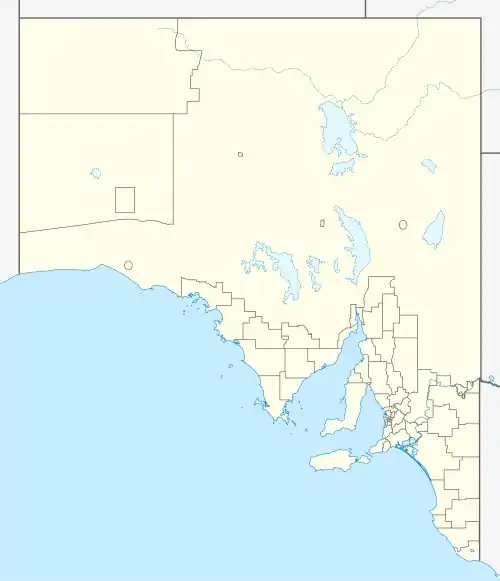
26°16′17″S 134°55′43″E / 26.2715°S 134.9285°E
Bloods Creek Station is a defunct pastoral lease that once operated as a sheep station and a cattle station in the Far North of South Australia.
The property is situated approximately 150 kilometres (93 mi) north of Oodnadatta and 169 kilometres (105 mi) east of Kulgera.
The traditional owners of the area are the Arunndta people, who remained on the property after the 1920s.[1]
The lease takes its name from Bloods Creek, which has some semi-permanent waterholes. The Overland Telegraph passed near one of the waterholes.[2]
In 1901 the state government drilled a 2,002 feet (610 m) bore and a large windmill was built to reach the hot sub-artesian water, which rose to within 140 feet (43 m) of the surface. The property was also once an important railhead for the original Ghan railway.
In 1905 the leaseholder was John Bailes, who had introduced Angora goats to the property.[3]
The lease was taken up by Ted Colson, the first white man to cross the Simpson Desert,[2] in 1931. Colson ran sheep, tended the bore and ran a store.[4] Later the lease was amalgamated into the Dalhousie pastoral company, along with Federal, Mount Dare and Dalhousie Springs leases[5] by Edwin Lowe.[2]
See also
References
- ↑ "Third Medical Relief Expedition among the Aborigines of South Australia". Retrieved 13 June 2016.
- 1 2 3 "Bloods Creek on the Overland Telegraph". Outback secrets. 14 December 2015. Archived from the original on 13 March 2016. Retrieved 12 June 2016.
- ↑ "The Illustrated Observer". Evening Journal (Adelaide). Vol. XXXIX, no. 10593. South Australia. 12 January 1905. p. 2. Retrieved 13 June 2016 – via National Library of Australia.
- ↑ C. J. Horne (1993). "Colson, Edmund Albert (1881–1950)". Australian Dictionary of Biography. National Centre of Biography, Australian National University. ISSN 1833-7538. Retrieved 12 June 2016.
- ↑ "Attractions". Government of South Australia. Archived from the original on 24 March 2016. Retrieved 13 June 2016.